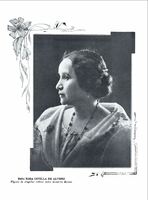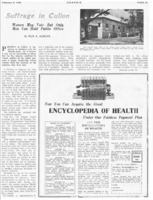In pre-colonial Filipino society, before the first Spaniards arrived to the Archipelago, there was a spiritual leader that figured as head of the community. This leader was called the Babaylan and the role was always occupied by a woman. The word shares its roots with the word “Babae” or “Babai”, which in Tagalog means “woman”. The Babaylan had knowledge on medicine and astrology, and was the person in charge of conducting rituals and deciding when to plant and harvest. In addition, her knowledge of medicine made the Babaylan essential for the community, because she provided essential care for the sick. Thus, the woman had a fundamental role in pre-colonial Filipino society as the one in charge of making important decisions for the community and of caring for its people.
Portrait of Rosa Sevilla de Alvero
Spanish rule
With the arrival of the Spaniards and with the Christianization of the territory, the figure of the Babaylan disappeared. Because of the religious groups that came to the isles, and the dependence of their teachings on the Bible, men were now taking the role of leaders. Women that were once present in economical and social affairs of the community were now secluded to the private sphere of the home. They lived to take care of the home, their husbands and their children, and they believed that such roles were what God had intended for women.
In the second part of the 19th century, things progressed. The Moyano Law (1857), a law regulating public education for both boys and girls, was also implemented in the Philippines six years later. This permitted girls to receive education and, later on, to form themselves academically. One of the most important advocates for education for women was Rosa Sevilla de Alvero. Although she followed Christian conventions and emphasized the importance of the family and the role of the woman within that marital institution, she opened the first school for women. She was a strong advocate for women’s rights and often gave speeches in which she promoted equality between men and women, women’s right to suffrage, and the inclusion of women in economic, political and social affairs. However, as one of the earliest feminists in the Philippines, Rosa Sevilla de Alvero possessed a conservative stance on matters such as divorce and the primordial role of women as mothers.
In 1896, the Spanish colonizers discovered a secret organization named the Katipunan led by Andrés Bonifacio. Its purpose was anti-colonialist and its members desired independence from the Peninsula. Throughout history, women have had an important role within nationalists movements. That was also the case during the Philippine revolution, as the Katipunan not only recruited men to aid in the fight for independence but also women, mostly the wives, sisters and daughters of the members (Roces 2002, 166-167). According to Mina C. Roces, “The Philippine revolution is a site from which one could observe the intersection of women’s dual (and sometimes contradictory) images as katulong [helpers] of the male-dominated revolutionary discourse and as agents of change” (Roces 2002, 166). They became helpers and companions to their husbands, as well as agents of change because of their role as mothers and the responsibility that lay on their shoulders to educate the future Filipinos. During the Revolution, women fought hand in hand with men for the cause they believed in. Christine Doran enumerates some of the roles women had during the uprising: they worked as soldiers, messengers, nurses, guards, mothers, spies, strategists and fundraisers (Doran 1999, 328). As can be deduced from this list, not all women fought physically during the Revolution, but some of them found other ways to fight: by using their knowledge and abilities, either as nurses or fundraisers, or as writers supporting the independent cause by means of open letters, newspaper articles or opinion pieces.
The Revolution that began in 1896 ended in 1898 with the Treaty of Paris. With this Treaty, Spain ceded control of the Philippines to the United States, with which Spain already had a war going on in another of its colonies, namely Cuba. This change of rulers in the Archipelago brought a new period of unrest, war and colonization to the Filipinos.
American rule
During the American occupation of the Philippines, many aspects changed in Filipino society. The concept of “modern” became popular and many women strived to be “modern women”. It was also the period of first-wave feminism, which advocated for the women’s right to vote. “Modernity” and “suffragism” were two of the most important and discussed concepts from the first decades of the twentieth century. It is important to highlight the fact that “modernity” during this period was highly associated with all that was American.
According to Mina Roces, women’s lives were greatly influenced by the American colonial policy. Roces states that “colonial policy gave women the chance to become leaders in the fields of education (where women were given scholarships on equal par with men to go to the United States for higher education), and civic work (the formation of women’s clubs was also influenced by American women in the Philippines)” (Roces 2002, 160). Although women were still confined mostly to the private sphere of the home, they often accompanied and substituted their husbands in political affairs, such as campaigning or giving speeches. This was accepted by society because of its perception of the woman as a helper to her husband. Furthermore, women obtained high positions in the educational institutions, often becoming directors or founders of schools, institutes, colleges and/or universities, and received visibility and appreciation in the public sphere. This was rapidly accepted by society because of women's responsibility of caring for and educating children.
Celebration of the women’s right to vote
Federation of Women’s Clubs (NFWC), formed in 1920, was the leading Filipino women’s organization. However, other women’s organizations were formed first, such as the Asociación Feminista Filipina (1905) and the Asociación Feminista Ilonga (1907), both containing the word “feminista” in their names, even though neither actually advocated suffragism. It was not until the 1920s that women started to actively and openly pursue the right to vote for women (Roces 2002, 176).
The first bill that would render women the possibility to vote was passed in 1933, but it had to be reintroduced later because of the Hare-Hawes Cutting Act (which was the first US law passed that set the date for the Philippine’s independence from the US).
In the 1930s, a dilemma arose for the Filipino woman. In 1935, women were allowed to vote for a constitution, but they were not yet allowed to vote for politicians in office.
Women who were in favor of suffrage extending to women pondered whether suffragism was an American colonial construct. “Modernity” was defined in terms of “American”, and by the 1920s, this included suffragism. In a country such as the Philippines, which desired its own independence, appropriating the colonizer’s ideas could be labeled as anti-nationalist. Filipino women had already rejected the construct of the “Maria Clara” that was prominent during the Spanish colonial period. Having left behind this construct, and not wanting to appropriate the American construction of the woman, there was a need to construct a new type of the modern Filipino woman. Filipino suffragists fought for their right to vote in typical Filipino attire; they did not appropriate the typical British suffragist dress but chose to wear the terno and the pañuelo (Roces 2004, 46).
It would be only in 1937, 17 years after women in the US were given the right to vote, that the right to suffrage was extended to the women of the Philippines. The law was passed after more than 300,000 women voted “yes” at a specially held plebiscite.
Bibliographic references
Aguilar San Juan, Delia. 1998. “The Philippine Centenary: Urgent Feminist Questions”. Amerasia Journal 24 (3): 27–36.
Carmen, Maria. 1954. “The Superior Normal School for Women Teachers in Manila 1893-98”. Philippine Studies: Historical and Ethnographic Viewpoints 2(3): 17-30.
Doran, Christine. 1999. “Women, Nationalism and the Philippine Revolution”. Nations and Nationalism 5(2): 237–58.
Friesen, Dorothy. 1989. “The Women’s Movement in the Philippines”. NWSA Journal 1(4): 676–88.
Garfinier, David E., and Josefina Z. Sevilla-Gardinier. 1989. "Rosa Sevilla de Alvero and the Instituto de Mujeres of Manila". Philippine Studies 37 (1): 29-51.
Hega, Mylene D., Veronica C. Alporha, and Meggan S. Eangelista. 2018. Feminism and the Women’s Movement in the Philippines. Struggles, Advances and Challenges. Pasig City: Friedrich-EbertStiftung Foundation.
Johnson, Roberta. 2019. Major Concepts in Spanish Feminist Theory. New York: Sunny Press.
Lacson, Katherine G. 2019. “The Rise of the Manileña Entrepreneur: Her Story in Periodicals from 1898-1938”. DLSU Business and Economics Review 28(3): 52-63.
Real Apolo, Carmelo. 2002. “Instituciones educativas femeninas en Filipinas bajo el dominio español”. Cuestiones Pedagógicas 16: 221-38.
Rivera, Cynthia Luz. 2004. “Filipino Women’s Magazines 1909-1940: Resistance, Cultural Subersion, and Compromise.” Plaridel 1(2) : 1-20.
Roces, Mina. 2002. “Women in Philippine Politics and Society.” In Mixed Blessing: The Impact of the American Colonial Experience on Politics and Society in the Philippines, edited by Hazel M. McFerson, 159-190. Greenwood Press.
Roces, Mina. 2004. “Is the suffragist an American colonial construct? Defining the ‘Filipino woman’ in colonial Philippines.” In Women’s Suffrage in Asia. Gender, nationalism and democracy, edited by Louise Edwards and Mina Roces, 24-58. RoutledgeCurzon.
Sánchez-Jiménez, David. 2010. “La hispanización y la identidad hispana en Filipinas”. CUNY New York City College of Technology,



